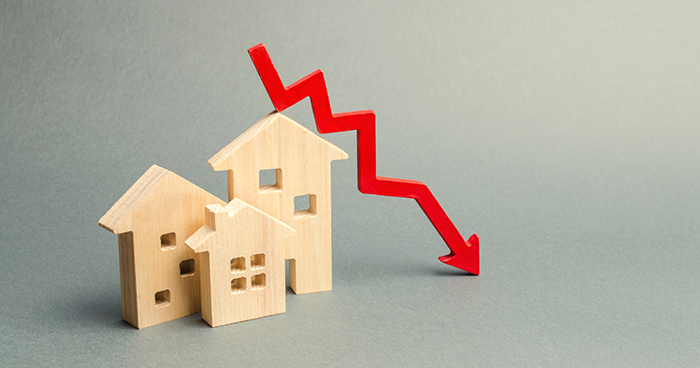
There is a transformation taking place within the UK’s ‘North-South divide’. The big recent headline has been the political swing from Labour to the Conservatives in many northern regions of England, but there has also been a reversal in the historical trend of stronger house price growth in southern regions versus those in the North.
For example, the Nationwide House Price Index shows prices in the northwest of England grew by 2.5 per cent last year, compared to a 1.7 per cent fall in London.
However, commentators that Mortgage Strategy spoke to believe the turnaround does not necessarily herald the start of a northern property powerhouse. Asked if this is more a sign of a growing North or a declining South, John Charcol senior technical manager Ray Boulger says: “It’s a combination of both.”
He points to Brexit uncertainty, the ‘assault’ on buy-to-let and increased stamp duty on high-value properties as all having a bigger impact in London and sometimes the wider South too, which has hindered price growth.
In addition, he says: “Prices in London and the South recovered much quicker than those in the North after the drop between autumn 2007 and spring 2009, and the price gap between London and the North increased so far that some people sold in London and bought elsewhere. Northern areas have been catching up.”
A spokesperson for Halifax, which also publishes a high-profile house price index, adds: “It is more likely London especially was underperforming. Prices in London and the South are able to grow less quickly because they are more stretched relative to incomes. Arguably, the greater impact of economic uncertainty on London and the South has also helped to restrain price growth.”
Nationwide senior economist Andrew Harvey says what has helped prices grow in the North recently is, ironically, their initial lack of growth after the financial crisis, which has made homes more affordable now.
He says: “The rebalancing of house price growth is not unexpected. In areas such as the North, Northwest, and Yorkshire & Humberside, prices are still fairly close to 2007 peaks, and mortgage payments for prospective first-time buyers are below their long-run average.
“Affordability is still more stretched in the South, with prices further above their pre-financial crisis levels, so raising a deposit is much more challenging.”
London effect
In the South, prices shot up in the three years to 2015 especially, according to Nationwide. It says that, while the cost of servicing a typical mortgage as a share of take-home pay remained close to long-term averages in most parts of the UK, the rapid price growth in London has made mortgage payments unaffordable for many.
The building society’s data shows the region that witnessed the biggest annual rise in the fourth quarter of 2019 was Scotland, at 2.8 per cent growth. Next was the West Midlands (2.7 per cent) and then the North (2.6 per cent).
In contrast, the weakest regions were London (1.8 per cent decline) and the outer Southeast (1 per cent decline). This compares to a UK-wide rise in house prices of 0.8 per cent over that period.
The pattern is replicated in other indices. The government’s most recent UK House Price Index, for November 2019, shows northern regions of England displaying stronger growth than the South over the preceding year, albeit the biggest rise came in Wales at 7.8 per cent.
Digging deeper, Halifax research shows eight areas of the Northwest featured in the top 10 towns for house price increases in 2019, although the Northeast’s Billingham in County Durham took top spot with a 12.3 per cent rise.
Another trend that points to a faster-moving market in northern regions comes from Barclays and Hometrack analysis of Zoopla listings. This shows that, while UK homes take on average 84 days to sell, Scotland’s biggest cities are fastest with 31 days in Edinburgh and 39 in Glasgow. Yet it takes 92 days in Brighton and 107 in London.
Harvey says we should not get carried away by the North-South reversal because “the annual rate of change among regions remained within a narrow range in 2019 of -2 per cent to 3 per cent, reflecting relatively subdued housing market conditions across the country”.
These trends contrast starkly with those of previous years, which saw big price rises in London and the Southeast, both in actual terms and versus the rest of the UK.
If you compare prices over the past two decades, southern regions are still by far those with the biggest growth. Halifax says in that period London prices rose the most, at 239 per cent, followed by East Anglia (238 per cent) and the Southwest (213 per cent).
At the other end, Northern Ireland recorded only 139 per cent growth, with Scotland witnessing a rise of 172 per cent and the North of England 185 per cent.
Nationwide expects UK-wide prices to be flat in 2020, but some commentators predict stronger growth given the relative political stability following the Conservatives’ significant majority in December’s general election.
The index from estate agent aggregator Rightmove shows a 2.3 per cent monthly increase in advertised prices in January – the largest such rise it has recorded at that time of year. It adds that there was a 15 per cent increase in buyer enquiries compared to the same period a year before.
Of course, data on asking prices must be treated with caution because it does not necessarily translate to sold prices. Yet some estate agents across the country are confident.
London-based agent Benham & Reeves’ director, Marc von Grundherr, says: “Things usually quieten before Christmas, but we had three times the number of offers in the last two weeks of December [after the election] than in the first two weeks.”
Yorkshire-based estate agent Manning Stainton is also upbeat. Managing director Mark Manning says: “There is renewed optimism because the political situation is seemingly settled. Regionally, we have solid foundations, so our market is in a really good position and we expect sales-agreed figures to be very good.”
Political influence
Boulger foresees the price gap between the North and the South continuing to shrink. He says: “Assuming Boris Johnson implements the stronger regional policy as promised in the Conservatives’ manifesto, the narrowing of the price differential between London and the North has further to go.
“If the Conservatives can persuade enough voters in the North to stick with them, this will have a positive impact on the housing market. However, the difference from the past three years is that prices in London will also rise, but by less than in the North.”
Halifax has a slightly different view, with a spokesperson explaining: “The underperformance of London appears to be waning, from both the reduction in uncertainty and the beneficial impact on mortgage affordability of falling mortgage rates – which might favour regions where affordability is already stretched.
“It would be reasonable to expect the pattern of a stronger North versus South to normalise.”



